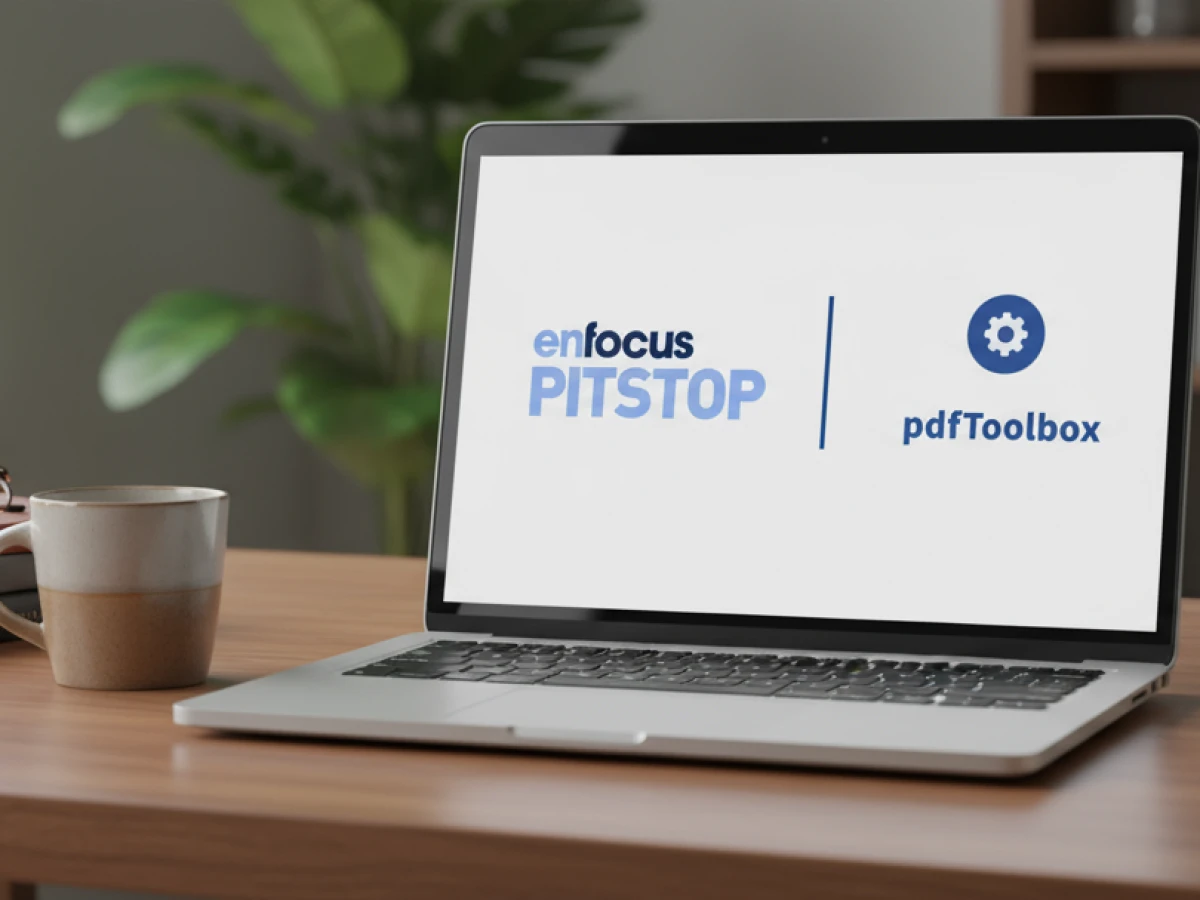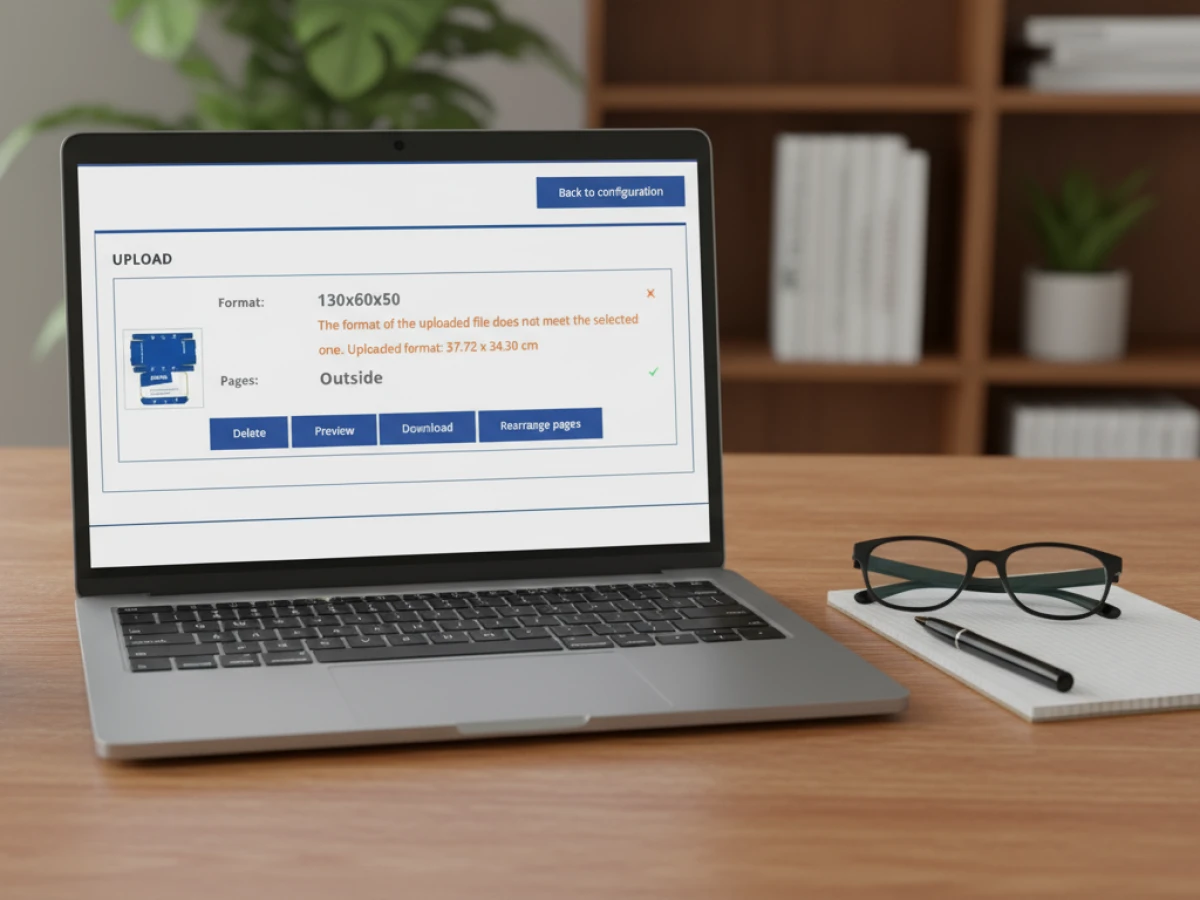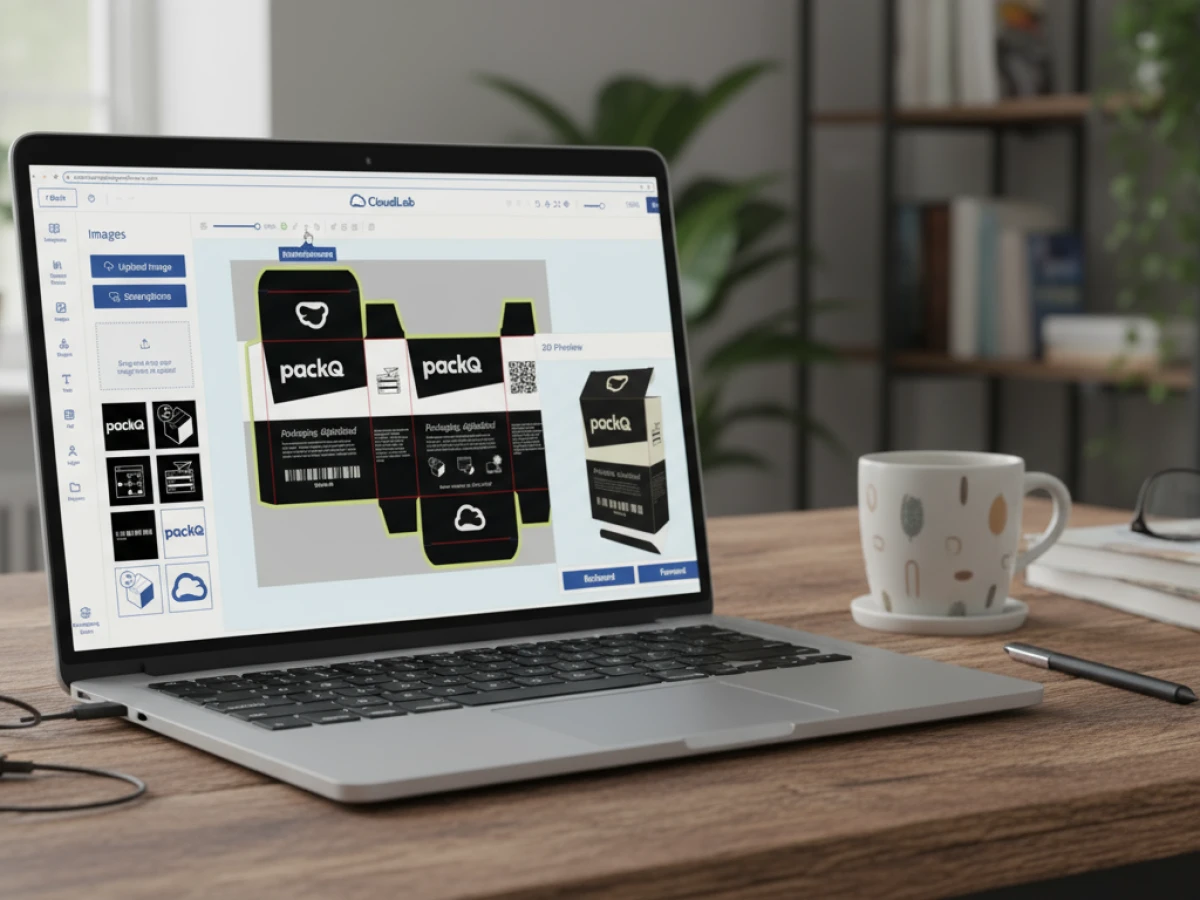Dynamic Preflight Check in packQ – Check your print data in real time

PackQ's dynamic preflight check analyzes print data in real time, even before an order is submitted. It checks resolution, color mode, fonts and bleed and uses leading technologies such as PitStop and pdfToolbox. The article explains how this process works, which errors it prevents, how it can be integrated into workflows and what benefits it offers for printers, designers and brand owners.
Quality starts with data verification
In today’s printing industry, every minute counts. Customers expect short lead times, while printed products need to be high quality and error‑free. But what happens when the supplied print data do not meet technical requirements? In many cases, errors are only discovered when the job is already in production. Wrong color profiles, missing fonts or low resolution lead to delays, rework and costly reprints.
To minimise this risk, packQ has developed a dynamic preflight check. Instead of checking data only after an order has been placed, packQ verifies them in real time during the online configuration. This article shows how dynamic preflights work, why they are indispensable for modern packaging workflows and what benefits they offer all stakeholders.
What does preflight mean in prepress?
Preflight—borrowed from aviation’s final pre‑takeoff check—is an established quality control procedure in the printing industry. Preflighting refers to analysing digital print files to ensure they meet all technical requirements. A preflight tool checks key parameters such as image resolution, fonts, color mode, bleed, transparency and file formats before sending the file to the RIP station or press. It serves as a safety check: when errors are detected early, costly reprints, waste and delays can be avoided.
Why preflight is indispensable
Digitalisation and the trend toward short turnaround times have greatly increased the number of jobs in printing. At the same time, demands for quality and personalisation have risen. Without systematic data checks, the following risks arise:
- Waste of materials: Faulty files cause misprints and material waste.
- Loss of time: Corrections after order entry delay the entire production schedule and extend delivery time.
- Dissatisfied customers: Faulty or late deliveries negatively affect customer satisfaction and can damage the brand image.
- Additional costs: Each reprint strains the budget—especially for custom or small runs.
A preflight check ensures these risks are minimised. With automated checks, files are systematically inspected so errors can be identified and corrected early.

From static to dynamic preflights
Traditionally, the preflight check was carried out only after a job was created or the print data had been uploaded. The customer would receive feedback after some time on whether their file was print‑ready. This “static” approach has several drawbacks: it extends processing time and does not allow the user to correct the file directly. In some cases, jobs are produced despite errors because rework is too time‑consuming.
Dynamic preflight checks go one step further: they inspect print data in real time during configuration or immediately after upload. Customers receive instant feedback and can correct errors directly. As a result, post‑processing times are reduced to an absolute minimum. packQ moves quality assurance to the beginning of the process.
Advantages of dynamic checks
- Real‑time feedback: As soon as a user uploads a file or changes dimensions, packQ analyses the data and displays deviations. Adjustments can be made directly before an order is placed.
- Shorter time‑to‑market: Because there are no later corrections, jobs move into production more quickly. This is a competitive advantage, especially for short runs or personalised packaging.
- Lower error rate: Dynamic preflights detect issues with fonts, colours, resolutions or bleed before they appear in the final product. This saves material and resources.
- Better customer experience: Customers feel more secure knowing that their data are checked in real time and that they can make improvements immediately.
Core functions of packQ’s dynamic preflight check
packQ combines proven industry standards with innovative features to provide comprehensive preflight checking. The following core functions are central.
Checking key parameters
packQ checks all relevant print data parameters such as:
- Image resolution: For high‑quality prints, at least 300 DPI are required. The preflight function detects images with low resolution and warns the user.
- Color mode: Images or graphics in the RGB colour space are converted to CMYK for printing to avoid colour shifts.
- Color profiles: ICC profiles are checked and adjusted as necessary to ensure exact colour reproduction.
- Fonts: The preflight ensures that all fonts used are embedded or converted to vectors. Missing or unlicensed fonts are detected.
- Bleed and page formats: It checks whether the necessary bleed is present and the page dimensions match the product dimensions.
- Transparency and layers: Transparent elements can lead to unexpected effects in print. packQ recognises such elements and warns the user.
By thoroughly checking these parameters, packQ ensures that the print data comply with technical specifications and can be sent to production without manual rework.
Immediate error analysis and user guidance
In addition to pure data analysis, packQ provides user‑friendly error displays. When the system detects deviations, users receive specific guidance:
- Warning messages with recommendations: packQ indicates which parameters need correcting and how (e.g. replace an image, adjust colour mode, embed a font).
- Visual markers: In the 3D designer and layout view, packQ highlights affected areas so users can immediately see where the error is.
- Live preview: Changes to the layout or print data are shown instantly. This allows users to see how adjustments affect the final product.
Integration of leading preflight tools
PackQ uses established preflight technologies such as Enfocus PitStop and callas pdfToolbox, which are among the market‑leading tools. These tools can be quickly integrated via a server licence and allow a precise analysis of PDF data. The integration makes it possible to perform advanced checks, such as the detection of:
- missing barcodes or inaccurate colour schemes,
- PDF/VT specifications for variable data printing,
- multi‑page documents and nested elements.
The combination of packQ’s interface and powerful preflight engines creates a seamless automated workflow from data validation to the final PDF output.

Flexible preflight profiles
Depending on the product type—folding cartons, corrugated board, POS displays or flexible packaging—different requirements apply. PackQ provides preconfigured preflight profiles that are adapted to specific materials and production processes. Users can customise these profiles and define their own rules to map company standards. For example, special requirements for ink coverage on food‑safe packaging or minimum line widths for delicate die cuts can be stored.
Automated correction processes
In addition to analysis, the dynamic preflight check offers automated corrections. If a file, for example, uses the wrong colour mode or lacks bleed, the system can automatically adjust these values. This reduces the workload for prepress staff and increases consistency. Critical errors that cannot be corrected automatically are clearly flagged so users can fix them.
How the dynamic preflight check is integrated into the packQ workflow
PackQ is designed as a headless web‑to‑pack system and offers numerous interfaces to shop systems, ERP applications, MIS and production machines. The dynamic preflight is an integral part of this overall system and supports automation across all steps.
Step 1: Upload and configuration
The customer designs their packaging via the browser‑based designer or uploads their own print data. PackQ analyses the data live as the user selects dimensions, materials and embellishments. This real‑time feedback ensures that all parameters are aligned. For example, it checks whether the resolution matches the chosen board thickness or whether the bleed suits the selected cutting layout.
Step 2: Dynamic preflight analysis
As soon as the user uploads the data, packQ automatically starts the preflight analysis. Based on the previously defined profiles, all relevant values are checked. The system uses PitStop and pdfToolbox to analyse deep PDF structures and identify potential problems. The results are displayed within seconds.
Step 3: User feedback and corrections
The analysis results are presented in an intuitive interface. Users can quickly make adjustments based on the hints. PackQ provides tools for image replacement, colour space conversion or integration of alternative fonts. Because of the close connection to the 3D designer, the user immediately sees how changes affect the visual appearance.
Step 4: Release and automatic transfer
Once all parameters are correct, the user releases the data. PackQ then generates a production‑ready PDF in the correct colour profile, including bleed, fold and cutting lines. At the same time, all information is passed to the ERP and MIS systems so that price calculation, material planning and production control can take place without manual intervention.
Step 5: Hotfolder integration and workflow automation
The finished data are dropped in a hotfolder assigned to the relevant production machine. This automatic transfer reduces the risk of errors and allows immediate processing. In combination with variable data (PDF/VT), personalised orders can also be processed quickly and safely.
Benefits of the dynamic preflight check for different target groups
For printers and packaging manufacturers
- Reduced waste: Early detection of errors reduces misprints and saves material and costs.
- Higher capacity utilisation: Automated data checking allows more jobs to be processed in parallel without overloading staff.
- Standardisation: Preconfigured profiles ensure that different product categories (ECMA, FEFCO) are always checked by the same rules.

For e‑commerce platforms and marketplaces
- Improved user experience: Customers receive immediate feedback on their files and can adjust their own designs without technical knowledge.
- Integration into checkout: The dynamic preflight can be seamlessly integrated into the order process so customers do not encounter unpleasant surprises.
- Scalability: Even with high order volumes, data quality remains constant because every upload is checked automatically.
For brand owners and designers
- Security for corporate design: Checking colour profiles and fonts ensures that brand guidelines are followed. Missing or incorrect colours are detected early.
- Rapid prototype creation: Marketing teams can test variations and immediately see whether technical requirements are met. This allows campaigns to be implemented faster.
- Integration of personalisation: In connection with variable data printing, serial numbers, QR codes or names are checked and output without errors.
For technology teams and developers
- API‑first architecture: The preflight service can be connected to existing systems via open interfaces.
- Easy maintenance: Thanks to the modular structure, preflight rules can be updated or new check parameters added without affecting other areas.
- Scalability: The server‑based architecture ensures stable performance even during peak loads.
Preflight and packaging standards: ECMA and FEFCO
Packaging is often developed based on established standards such as ECMA and FEFCO. These codes define the shape and construction of folding cartons and corrugated packaging and ensure smooth production. packQ’s dynamic preflight takes these standards into account when checking print data. It checks, for example, whether crease lines, flaps and glue areas are placed correctly and whether the size of the bleed margins meets the norms.
The preflight can also verify whether the placement of barcodes, warning texts or symbols complies with legal requirements. This is particularly important for industries such as pharmaceuticals or food, where correct labelling is mandatory. By combining standard templates with dynamic data checks, it is ensured that every packaging design is not only aesthetically pleasing but also functional and legally compliant.
Another advantage of the standards is that they allow CAD data to be automated. packQ automatically generates the correct die lines and layouts based on the selected ECMA or FEFCO code. The preflight then checks these generated outlines to ensure that all technical parameters are met. This creates a closed loop from selecting the standard through data checking to final production.
Technical background: How the dynamic preflight works in detail
Preflight rules and profiles
At its core, the preflight check is based on rule sets that define which parameters are checked. These rules can be generic for all print jobs or specific to certain materials, sizes or finishes. packQ provides standard profiles based on industry norms. Companies can copy these profiles, edit them and add their own parameters.
Analysis of the PDF structure
PDFs consist of various layers: images, vectors, text, colour profiles and metadata. Preflight tools like PitStop and pdfToolbox analyse these layers and check whether they are suitable for printing. For example, they ensure that images are not only stored at sufficient resolution but also contain no transparency problems. They also check whether all fonts are embedded and whether the document conforms to the agreed page format.
Automated correction mechanisms
During the preflight analysis, certain adjustments can be made automatically, for example:
- Conversion from RGB to CMYK: Image data are converted to the correct colour mode.
- Adding bleed: If a document has no bleed, the system adds a defined margin.
- Embedding fonts: Missing fonts can be replaced by standard fonts or embedded if licences are available.
Other errors, such as the use of unlicensed fonts or choosing the wrong material, are reported to the user for manual correction.
Integration into variable data processes
Variable data requires special attention: each data set (name, QR code, serial number) must be correctly positioned and formatted. The dynamic preflight can ensure that these variables have the required resolution and the correct format. For large series, the system checks samples or all data sets, depending on the setting, to ensure that personalisation is error‑free.

Reports and documentation
After the preflight analysis is complete, packQ creates a detailed report. This documents all checks performed, identified errors, automatic corrections and remaining tasks. These reports are useful for internal quality control and for communicating with customers, making it clear what changes have been made to their data.
Best practices for implementing a dynamic preflight check
Define clear parameters
Before introducing a preflight, companies should create a list of all criteria relevant to their products. These include minimum resolutions, colour requirements, material tolerances and special requirements such as food‑safe inks.
Use standards and profiles
Use the predefined preflight profiles as a starting point and adapt them to your portfolio. If you produce folding cartons according to ECMA codes, you should define special parameters for flaps, crease lines and glue areas. For corrugated packaging according to FEFCO standards, different tolerances may apply.
Training and onboarding
Even though the preflight check is automated, users need a basic understanding of how to interpret the results. Training helps to understand the messages and take appropriate corrective measures.
Continuous optimisation
The printing industry and the materials used are constantly evolving. Regularly review your preflight rules and adapt them to new materials, colours or printing processes. Gather feedback from production to identify and eliminate further sources of errors.
Test integration into the workflow
Before the dynamic preflight check is used productively, you should test with real data. Check that the interfaces to shop, ERP and MIS work smoothly. Make sure that the checks do not impair system performance, even when many users are uploading data at the same time.
Challenges and solutions
Complex files and special cases
Some print jobs contain unusual file formats, special colours or special finishes (for example metallic effects). These require individual checking rules. PackQ allows you to create your own profiles for such special cases. For complex layouts, a manual pre‑check may be useful before running the automated preflight.

Different levels of user competence
Designers, marketing staff and end customers have different levels of expertise. A technical preflight report can overwhelm them. PackQ addresses this problem with role‑based views: lay users see simple hints (“increase image resolution”), whereas prepress experts can view detailed error messages.
Data volume and performance
Especially in mass customisation and variable data, hundreds of data sets can be uploaded simultaneously. To ensure performance, packQ scales the preflight service horizontally. In addition, random sampling is used to check whether quality remains consistent without having to analyse each data set individually.
Interoperability with third‑party software
Many companies already use existing prepress solutions. PackQ is open to integration: the dynamic preflight can be embedded as a standalone service via API into other systems or vice versa. This allows you to continue using your existing tools while benefiting from real‑time checking.
What does the future of preflight technology look like?
Preflight technology is not standing still. Some developments that are likely to become more important in the coming years include:
- Artificial intelligence: AI algorithms will help identify patterns in misprints and automatically adapt preflight rules. They could even predict which errors are most likely with certain file types.
- Machine learning for variable data: With large personalised campaigns, machine learning can identify patterns and automatically sort out faulty data sets.
- Cloud‑based solutions: More and more preflight systems will be available as cloud services. This enables rapid updates, distributed analysis and global access.
- Real‑time collaboration: Designers and customers can work on the same project simultaneously and immediately see how changes affect printability.
- Augmented reality: Future tools could display preflight results as AR overlays in the 3D viewer, giving the user an even more intuitive understanding of potential issues.
The dynamic preflight check safeguards quality and efficiency
packQ’s dynamic preflight check takes print data checking to a new level. Instead of revealing errors only after an order has been placed, the system analyses all key parameters during online configuration. It checks resolution, fonts, colours, bleed and much more, using established tools like PitStop and pdfToolbox to ensure maximum precision. Error rates, material waste and rework are reduced while speed and quality of production increase.
For packaging manufacturers, brands, e‑commerce platforms and developers, packQ’s dynamic preflight provides clear benefits: it improves efficiency, increases customer satisfaction and lays the foundation for scalable and automated workflows. In an industry driven by speed, individualisation and quality, the preflight check is therefore an indispensable tool.
FAQs about the dynamic preflight check
What is the difference between static and dynamic preflight?
A static preflight checks print data only after an order has been received, while a dynamic preflight analyses the data in real time and provides immediate feedback. This allows errors to be corrected before the order is placed, saving time and costs.
Which data parameters are checked by the preflight?
The dynamic preflight analyses, among other things, image resolution, colour mode (RGB/CMYK), embedded or missing fonts, bleed, page formats, colour profiles and transparency. All relevant components are checked for their printability.
Can the preflight automatically correct errors?
Yes. Certain errors, such as missing bleed or incorrect colour modes, can be corrected automatically. PackQ creates a new, print‑ready PDF and flags critical issues that must be resolved manually.
How complex is it to integrate the preflight check into existing systems?
Thanks to the API‑first architecture, the dynamic preflight can be integrated as a standalone service into existing e‑commerce platforms or workflow systems. Often a short setup and profile definition are sufficient to use the service productively.
What are the next steps if I want to test packQ’s dynamic preflight?
Interested companies can arrange a non‑binding demo, request a white paper or use the sandbox to test the functions. A discussion with the experts at CloudLab helps analyse individual requirements and work out the optimal implementation path.
Introducing our product features:
https://www.packagingdesignsoftware.com/feature/dynamic-preflight-check
https://www.packagingdesignsoftware.com/feature/ai-designer-suite
https://www.packagingdesignsoftware.com/feature/ecma-fefco-packq-box-library
https://www.packagingdesignsoftware.com/feature/production-workflow


.webp)
.webp)

